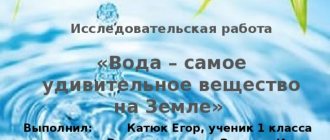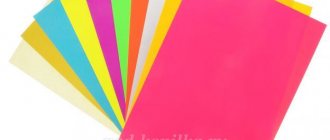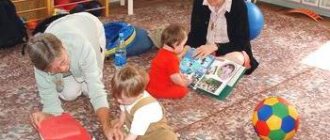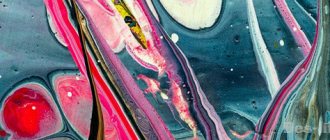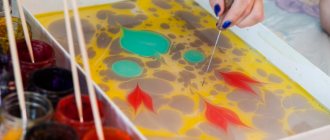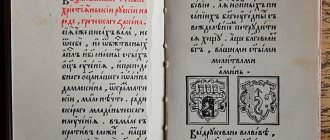Design and research work “Paper: history, properties, types, application and production.”
The technological flow chart for paper production consists of several processes. All stages of papermaking production are carried out on high-performance machines.
1. Preparation of paper pulp (grinding and mixing components, sizing, filling and coloring of paper pulp).
The production of cellulose involves mechanical processing of wood and then chemical reactions with sawdust.
Grinding and mixing.
Coniferous trees are ground into fine sawdust. These sawdust are placed in a boiling solution containing NaHSO4 (sodium hydrogen sulfide) and SO2 (sulfur dioxide). Boiling is carried out at high pressure for many hours. In this case, a chemical reaction occurs in the solution, as a result of which the substance hemicellulose and the substance lignin (a mixture of aromatic hydrocarbons) are obtained, as well as the main reaction product - pure cellulose, which precipitates.
Next, the sediment is crushed using rolls, resulting in cellulose particles of about 1 mm. And when such particles get into water, they immediately swell and form a suspension of cellulose fibers in water - a dark brown pulp. Subsequently, this pulp is bleached.
To make the paper suitable for writing and give it hydrophobic properties, bleached and crushed kaolin, glue, and tint are introduced into the paper pulp and everything is mixed in the required proportions.
Sizing.
The purpose of sizing is to give paper or cardboard
limited absorbent properties in relation to water, ink, printing ink and other liquids and improvement of many other physical and mechanical properties.
Hydrophobic (water-repellent) substances are used for sizing. This can be starch, animal glue, rosin extracted from the resin of coniferous trees, or a special ready-made glue. These substances envelop cellulose fibers, which gives them moisture resistance and mechanical strength.
Filling
is the introduction of mineral filler substances into the paper composition to improve its quality and economic performance. This has the following goals: reducing the cost of paper, increasing its whiteness, increasing the smoothness of the paper surface, reducing opacity, increasing softness and ductility, reducing bulk density, porosity and, consequently, the absorption of printing inks, etc.
One of the oldest fillers is kaolin - an earthy mass similar in composition to clays or talc - a compound from the silicate class. CaCO3 chalk (calcium carbonate) is used as a filler to improve printing properties, to increase the whiteness, smoothness, softness and opacity of paper, which is why such papers are called coated. To increase the wet strength of paper, urea and melamine-formaldehyde resins are added. Titanium dioxide TiO2 is used in the production of coated papers. Zinc oxide ZnO is used as a filler for special types of paper.
Project on the benefits of paper
Slide 1
The benefits of paper in our life. Research work of Makarova Alena 4 “B” class MBOU gymnasium No. 1 Supervisor: Yakovleva Larisa Yurievna
Slide 2
I love to draw, paint, and make various applications. At school we write in notebooks and record homework in a diary. The teacher puts grades in the class journal! Modern man cannot imagine himself without paper! Sometimes we don’t even think about how much we spend endlessly!
Slide 3
STOP! IMAGINE IT IS NOT. WHAT TO DO? IT'S SCARY TO EVEN THINK! -What does paper mean? -who invented it? -who invented it and from what, how was it made before and how is it produced now? -How great is its benefit in our lives?
Slide 4
Topic: “The benefits of paper in our lives.”
Slide 5
Purpose of the work: to find out the benefits of paper in our lives. Hypothesis: paper has various properties that people use in industry, medicine, and in everyday life. Object of study: various types of paper. Relevance of the topic: everyone needs paper. Practical significance: the results of my work can be useful in the lessons of fine arts, technology, and the surrounding world.
Slide 6
Research methods: method of analyzing literature on the topic of work; experimental method; sociological survey with
Slide 7
What do I know about paper? I believe that paper is a material for printing and also for other purposes. Most of the home furnishings are paper related.
Slide 8
Meaning of the word "paper". Paper (from Italian bambagia - cotton) is a material consisting of specially processed small plant fibers, closely intertwined and forming a thin sheet.
Slide 9
History of paper as a writing material. Paper did not always exist. A variety of things served as writing materials: drawings on cave walls, clay tablets, papyrus, parchment. Paper was invented by Cai Lun in China 2000 years ago. He found a way to make paper from the fibrous inner bark of the mulberry tree. Gradually, the art of making paper spread throughout the world.
Slide 10
How is paper made? The lumberjacks cut down the tree, divided it into parts on a machine, chopped the logs into chips, and boiled them in a solution for a long time. And then all the liquid is squeezed out, ironed with a roller, dried, ironed. This is how a blank sheet of paper comes out for a magazine, book and notebook.
Slide 13
Experiments with paper. Paper properties. Experiment No. 1 Conclusion: paper is afraid of water. All paper items deteriorate when exposed to water. Paper is a fragile material
Slide 14
Experiment No. 2 (with oil)
Slide 15
Experiment No. 3 Invisible ink.
Slide 16
The letters became visible when the paper was heated. Invisible ink for secret correspondence was used in ancient times
Slide 17
Games with paper. Paper crafts.
Slide 20
Results of my sociological survey: 29 people took part in the survey. The guys don't know much about paper and its use. Before working on the project, I also knew little interesting about such a common material as paper. Now I have learned a lot of interesting things about her.
Slide 21
Interesting facts about paper. -350 million tons of paper are produced worldwide every year. — 25 kg of paper per year is used by the average resident of Russia. “It turns out that cutting yourself with paper is as easy as shelling pears, because a sheet of paper is no thicker than a razor blade—only 100 micromillimeters.” -Paper has the same energy value as potatoes! -500 thousand tons of paper waste are generated in Moscow alone in one year. -Catherine II 240 years ago thought and decided that paper could be used in monetary relations. It was then, by decree of the empress, that the first paper money appeared.
Summary of educational activities with children 4-5 years old using ICT “Paper and its properties”
author: Selikhova Ekaterina Aleksandrovna
Teacher Kindergarten No. 568 Yekaterinburg
Summary of educational activities with children 4-5 years old using ICT “Paper and its properties”
Direct educational activities with children of the middle group “Paper, its properties and types.”
Goal: to continue to form children’s ideas about the properties and types of paper.
Tasks:
Educational : _
expand children’s understanding of paper production, its different types and properties;
Developing : _ _
replenish children's knowledge about the characteristics of paper, develop analytical thinking, memory, attention, observation. Learn to conduct experiments.
Educational:
to cultivate interest in the properties of the objects around us, curiosity, and respect for natural resources.
Materials and equipment : chest, scissors, ball, paper, cardboard, matches, samples of different types of paper, album sheet, glue, brushes, napkins.
ICT : projector, screen, presentation “How paper appeared”
GCD move
Educator: Guys! Today we have guests. Let's welcome our guests!
Friend on the left, friend on the right
The result is an even circle.
We will all join hands,
and let's smile at each other.
- Guys, today we have an unusual activity, a little bit magical. We will experiment with you. You will find out what we will experiment with by guessing the riddle. I brought this wonderful chest (there are different types of paper in the chest). A riddle will tell us what lies in it:
“It can be a document,
poster, candy wrapper, envelope,
letter, wallpaper, leaflet,
album, book, packaging" (paper)
- That's right guys, it's paper.
“Now it’s simply impossible to imagine life without paper.
-What is paper needed for?
- Remember where paper is used?
- But did people always have paper? (children answer negatively)
Educator: -What do you think people wrote on in ancient times? (On the rocks, on the rocks).
At different times people wrote on different materials. - How many of you know how paper is made?
Educator:
View the presentation.
Slide 1: Title page. Slide 2: Long before the advent of paper... in ancient times, people hollowed out inscriptions on stones and made rock paintings. Slide 3: In ancient Greece they wrote on damp clay tiles and tablets filled with wax, squeezing out letters with a sharp stick. They were inconvenient to carry and store. They were heavy, fragile and easily broken. Slide 4: In ancient Egypt, a plant was found on the banks of the Nile River - papyrus. Its stems were cut into thin strips, smeared with glue, ironed with a wooden smoothing iron, dried in the sun and rolled into a tube. They drew and wrote on papyrus with thin sticks. The length of such a book was 100 steps. Slide 5: Parchment was first made in the state of Pergamum in Asia. It was made from the skins of calves and sheep. Sometimes a book written on parchment was worth more than a house, because it took a herd of calves or sheep to make it. What was she like? The book resembled a chest. Slide 6: In Russia they wrote on birch bark. This is birch bark. At first they wrote letters on it, and then books. What did you write with? They scratched it with a bone or iron writing. Slide 7: The inventor Cai Lun first learned to make paper in China. A sticky mixture of bamboo and water was rolled into a flat sheet and dried in the sun. Slide 8: Nowadays, paper is produced at pulp and paper mills from wood of almost all tree species. The lumberjacks cut down the tree, divided it into parts on a machine, chopped the logs into chips, and boiled them in a solution for a long time. And then all the liquid is squeezed out, ironed with a roller, dried, ironed. This is how a blank sheet of paper comes out for a magazine, book and notebook.
OA process
-Now think and tell me, can it be that all objects and things are made of paper? (children's answers).
— Why do you think they don’t make furniture or sew clothes from paper? (various options for children's answers).
-Houses are built from stone, clothes are made from fabric. Because these materials are durable and reliable.
— Is the paper durable? We will check.
I want to invite you to the workshop where we will conduct experiments with paper. Do you want to visit there? Then close your eyes and say all together: -One, two, three, come into the workshop. (Children enter the workshop, I draw the children’s attention to the plates where the pieces of paper lie).
Experimental part.
Studying the properties of paper.
And now we will find out what kind of paper there is. Pick up the paper that is lying on your tables, touch it.
What can you say about her, what is she like? (Children take turns trying the paper by touch, identifying it by touch and describing its properties).
But we will now find out what properties paper has and for this we will conduct a series of experiments:
1) To begin with, take a sheet of paper and a sheet of cardboard in your hands and try to crumple it? Wrinkles? Twist it? Bend? (twists, bends). (Children's answers).
Conclusion: the thicker the paper, the more difficult it is to fold, curl , and bend .
2) Now tear it up. Is it torn? Sturdy paper?
The paper tears, which means it is fragile.
Conclusion: cardboard is thicker than paper, paper tears easily depending on the thickness.
3) Take scissors and cut first the paper, then the cardboard.
Conclusion: cardboard is thicker than paper. The paper is cut according to ease depending on its thickness.
Do you think it is possible to join the paper? How? (Glue, sew, intertwine).
4) Now put a sheet of paper in a container of water. First dip a napkin into the water, then a landscape piece of paper. What happened?
Conclusion: thin paper gets wet faster and falls apart, thicker paper also gets wet, but it will take longer. Paper is afraid of water, paper is not a durable material.
5) Look, guys, now I’ll set the paper on fire. What happened to her?
Conclusion: the paper burns.
6) Now let's experiment, how does a piece of paper fall?
Raise a piece of paper above your head and release it from your hands. It falls smoothly, swaying in different directions. Tear off a narrow strip from it, lift it above your head and release it. It falls differently: rotating around its axis from top to bottom, i.e., the paper falls in different ways.
Research findings.
- Paper can be thin or thick in structure.
- 2. Paper can be strong or weak.
- Paper is afraid of water.
- Paper can be cut with scissors or torn by hand.
- "The paper is burning"
Game "Magic Paper"
I'll throw the ball to you. Whoever catches it must say what can be made from paper (books, notebooks, boxes, wallpaper, etc.).
And now we’ll tell you what you can do with paper (draw, cut, glue, crumple, tear, etc.).
Final part Well done! Well, it's time to return from the workshop. Let's close our eyes and say the words:
One, two, three, come back to the group. We found ourselves in a group again.
Reflection
Was it interesting in the workshop? What new things have you learned about paper?
Summary of educational activities with children 4-5 years old using ICT “Paper and its properties”
Experimental research project “The Wonderful World of Paper”.
Progress of the lesson:
Educator: Invites the children to guess the riddle:
Glue together a ship, a soldier,
Steam locomotive, car, sword.
And it will help you guys
Multi-colored... (paper)
- Yes, guys, today our lesson is devoted to paper. Look what's on my table? This is a stone, birch bark and a sheet of paper. What could they have in common? Try drawing lines on a stone with gouache, scratching letters on birch bark and writing them on paper with a pencil. Previously, people used all these materials to send written messages to each other. First they drew on stones, then wrote on birch bark letters. The first paper appeared in China. Look around and name items that were made with paper. How often and for what purposes do we need this material? (napkins, wallpaper, toilet paper, postcards, books, magazines, newspapers, boxes, notebooks, etc.)
And now I invite you to play a game: Imagine that the paper has disappeared. How will your life change in this case? Can you replace paper with something? (children's answers).
I'll tell you how paper is made. The fact is that paper consists of cellulose fibers. Cellulose is a substance that can be found in all plants, trees, cotton, rice, corn stalks, etc. Come to the board, I will show you a diagram of paper production. Paper is made at special mills. They are called pulp and paper. But first the trees in the forest are cut down. The logs are taken to the factory. Here they are cleared of bark and ground into small pieces - crushed in a machine (crusher). The resulting crumb is mixed with a special liquid, turning it into a soft mass. It goes to making paper. Guys, we learned the process of paper production, we realized that we use a lot of paper in our lives, and that it is very difficult for a person to live without paper. And in order not to needlessly cut down trees in the forest, we need to be more careful with paper. It is more economical to use it in our everyday life: do not throw away the books and magazines you read, but ask your parents to hand them over to waste paper, where the paper will get a second life. And now we will find out what kind of paper there is. (Children take turns touching the paper lying in the “sensation box”, identify it by touch and describe its properties). I suggest you crumple the paper (crumples), tear it (tears, fragile), put it in a bowl of water (gets wet). And now I will show you how paper burns. We have learned that paper is fragile, it wrinkles, tears, burns and gets wet. You are already well acquainted with the properties of paper, and I invite you to play the game. For this we need a hero - a paper man. I suggest choosing one of you. Let's put a paper cap and a paper cape on him. Let's imagine that our hero finds himself in a fairy tale, where many dangers await him. What exactly could threaten our hero, made of paper? Can he swim across the river?, And jump over the fire? Look, this is a danger map. Our hero will try to walk along it, and we will help him. The map shows “fairy-tale” obstacles that our paper man may encounter. Our hero’s task is to walk along the path, explaining what obstacles he must avoid and why. Is it possible to say about our hero that he “doesn’t burn in fire and doesn’t drown in water?”
